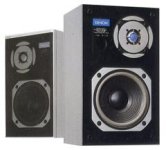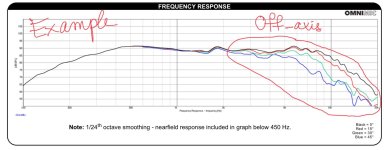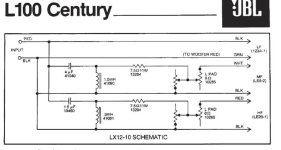I disassembled the vintage two-way bookshelf speakers: Denon SC-C3. I was a bit surprised with their crossover networks. They have only high-pass filter on the tweeter comprising a 3.3uF and a 0.47mH combo forming a second-order filter. And they have no low-pass filter for the woofer. The sticker on the cabinet is labeled crossover point at 4kHz which is consistent with high-pass’s component values.
Although I was surprised, I could remember that there’s a case in which the designer may intend to utilize the “natural roll-off“ of the woofer. However, by doing this, there are few disadvantages which are the dispersion, woofer’s break-up/beaming and off-axis radiation problems. So, does it mean these issues could actually be ignored?
If so, what would be the tricks for using this method? I mean how to choose the proper crossover frequency for the high-pass filter of the tweeter with the presence of woofer’s off-axis response variety i.e. 15, 30, 45, 60 degrees? Because, in typical configuration, the woofer would be employed low-pass filter below the frequency where off-axis variation curves occur.
Although I was surprised, I could remember that there’s a case in which the designer may intend to utilize the “natural roll-off“ of the woofer. However, by doing this, there are few disadvantages which are the dispersion, woofer’s break-up/beaming and off-axis radiation problems. So, does it mean these issues could actually be ignored?
If so, what would be the tricks for using this method? I mean how to choose the proper crossover frequency for the high-pass filter of the tweeter with the presence of woofer’s off-axis response variety i.e. 15, 30, 45, 60 degrees? Because, in typical configuration, the woofer would be employed low-pass filter below the frequency where off-axis variation curves occur.
Attachments
They did not ignore the unwanted effects, they used the materials and properties to get away with the cheapest possible way to build the speaker. The most important thing on it is the foam surround which gives the lowest losses and highest inner damping at the cheapest possible cost. These four properties are the reason why foam surrounds were the most popular type in the eighties.
Which dissolve into crumbles soon or already have in the last 30 years.
The diversion of the dispersion above 4k is pretty mild if you want to compare it to other cheap speakers of the time. Don't forget, they were sold with a MSRP of ~100 bucks.
Honestly, there were tons of speakers of renowned brands on the market which measured immensely worse and sounded like they measured. There's nothing wrong with the Denon speakers, that's normal for entry level speakers and compact stereo sets. You usually get a lot worse when buying entry level hifi or (much, MUCH worse) HT sets.
I know it probably hurts you but Deno is not the knight in the shining armor you'd like them to be - all and every brand got their bodies in the cellar because they wanted to make money of off their names. And no, JBL, Klipsch etc are not the honest, honorable exceptions, everyone did it and still does it.
Which dissolve into crumbles soon or already have in the last 30 years.
The diversion of the dispersion above 4k is pretty mild if you want to compare it to other cheap speakers of the time. Don't forget, they were sold with a MSRP of ~100 bucks.
Honestly, there were tons of speakers of renowned brands on the market which measured immensely worse and sounded like they measured. There's nothing wrong with the Denon speakers, that's normal for entry level speakers and compact stereo sets. You usually get a lot worse when buying entry level hifi or (much, MUCH worse) HT sets.
I know it probably hurts you but Deno is not the knight in the shining armor you'd like them to be - all and every brand got their bodies in the cellar because they wanted to make money of off their names. And no, JBL, Klipsch etc are not the honest, honorable exceptions, everyone did it and still does it.
Yeah, business!
The products are products for consumers, to make consumers consume. It is very important to realize that businesses have very different limitations and requirements for "speakers" as they are products that need to make profit, sound means about nothing. Costs slashed to minimum and designed for mass manufacturing. Yeah the sound needs to be good enough, 100$ speaker needs to sound better than 50$ speaker but that's it, sound is secondary value, it's more important to have low cost and in mass manufacturing every unnecessary screw and micron of paint gets expensive, so everything is stripped to bare bones. It's enough the product looks and smells like a speaker.
If one does DIY speakers and objective is not to save on cost, like with 99% commercial stuff, but make good sound, you could ignore all commercial stuff basically. Even the "high-end" products could be rather silly. Go directly to professional live sound or studio sound products, and look for the bit more expensive models that have good solid engineering. Even better, study what makes good sound and engineering to be able to spot products with high value = good engineering and good price.
The products are products for consumers, to make consumers consume. It is very important to realize that businesses have very different limitations and requirements for "speakers" as they are products that need to make profit, sound means about nothing. Costs slashed to minimum and designed for mass manufacturing. Yeah the sound needs to be good enough, 100$ speaker needs to sound better than 50$ speaker but that's it, sound is secondary value, it's more important to have low cost and in mass manufacturing every unnecessary screw and micron of paint gets expensive, so everything is stripped to bare bones. It's enough the product looks and smells like a speaker.
If one does DIY speakers and objective is not to save on cost, like with 99% commercial stuff, but make good sound, you could ignore all commercial stuff basically. Even the "high-end" products could be rather silly. Go directly to professional live sound or studio sound products, and look for the bit more expensive models that have good solid engineering. Even better, study what makes good sound and engineering to be able to spot products with high value = good engineering and good price.
Absolutely but on DIY speakers you could cut the optical nonsense and develop it for actually sounding good. Aside from that, the crossover calculator doesn't care for the baffle step or the actual impedance. And at 4k it will be a lot higher than 6 Ohm because of the impedance rise by the inductance of the woofer. Or the tweeter. Or both. I doubt the calculation is anywhere remotely correct since because of the impedance it would be a wonder if it's not of by a half or whole octave. And even if it would be correct, that doesn't mean it's correct at all since it doesn't account for the driver frequency response either. I would not rely on that in any way to judge the speaker or xo. Yes, it's cheap as it gets but there are to much assumptions for any classification other than the speaker is cheap-o "don't ask any questions, you've already bought it"
Well, nobody has replied the technical questions yet.
According to the attached example, which curve of the off-axis responses should be considered; 0, 15, 30, 45 deg, for selecting high-pass frequency for the tweeter, in case we’d use the natural roll-off of the woofer—no low-pass on the woofer?
According to the attached example, which curve of the off-axis responses should be considered; 0, 15, 30, 45 deg, for selecting high-pass frequency for the tweeter, in case we’d use the natural roll-off of the woofer—no low-pass on the woofer?
Attachments
Ideally a woofer with steep roll off.
So yes not ideal and yes ignored for cost.
And yes off axis would have a big dip off axis.
2nd order high pass is a step up actually from many
Many just had a capacitor for tweeter and that is it
Being a small woofer top end is high enough on axis.
But the low cost tweeter needs to crossed high.
They are very aware of these issues.
It is one way to make low cost speakers.
Id say it is good sound reference for a system with such simple
crossover since you can listen and know how cheap you can go.
Compared to fullrange or just a wideband woofer.
Even a cheap tweeter will have more detail.
Mylar or fabric dome would need padding resistor.
So many systems often use a piezo tweet with no waveguide.
Since sensitivity is low around 85 to 87 dB so not even padding
is needed and is close match to woofer likely about the same.
Or often the tweeter is a little bright, But you just fix it with" active"
system otherwise known as bass treble controls on amplifier
So yes not ideal and yes ignored for cost.
And yes off axis would have a big dip off axis.
2nd order high pass is a step up actually from many
Many just had a capacitor for tweeter and that is it
Being a small woofer top end is high enough on axis.
But the low cost tweeter needs to crossed high.
They are very aware of these issues.
It is one way to make low cost speakers.
Id say it is good sound reference for a system with such simple
crossover since you can listen and know how cheap you can go.
Compared to fullrange or just a wideband woofer.
Even a cheap tweeter will have more detail.
Mylar or fabric dome would need padding resistor.
So many systems often use a piezo tweet with no waveguide.
Since sensitivity is low around 85 to 87 dB so not even padding
is needed and is close match to woofer likely about the same.
Or often the tweeter is a little bright, But you just fix it with" active"
system otherwise known as bass treble controls on amplifier
Last edited:
Well, nobody has replied the technical questions yet.
According to the attached example, which curve of the off-axis responses should be considered; 0, 15, 30, 45 deg, for selecting high-pass frequency for the tweeter, in case we’d use the natural roll-off of the woofer—no low-pass on the woofer?
The one that matches the dispersion of your Tweeter. At least if not distortion or decay demand a lower crossover frequency.
E: At this speaker that didn't come into play. They determined that the crossover is too expensive so they didn't get it. If it wasn't clear yet, it is not a well developed speaker so they ditched every aspect and did with what they could get away. Nothing much else left there to learn from it.
Last edited:
Mylar or fabric dome would need padding resistor.
The dome tweeters material does not determine if a padding resistor or voltage divider is needed. The spl does.
correct , which was the point.The dome tweeters material does not determine if a padding resistor or voltage divider is needed. The spl does.
Those tweeter types generally have higher SPL
and require padding.
Tiny elements require none or 2 to 3 dB difference again accepted for cost.
When other types would have 6 to 10 dB difference.
Lots of ways to skin a cat or save a buck
E: At this speaker that didn't come into play. They determined that the crossover is too expensive so they didn't get it. If it wasn't clear yet, it is not a well developed speaker so they ditched every aspect and did with what they could get away. Nothing much else left there to learn from it.
Actually, I was also inspired by the JBL L100 Century. I found they have only high-pass sections without any low-pass‘s at all as well.
Attachments
Actually, I was also inspired by the JBL L100 Century. I found they have only high-pass sections without any low-pass‘s at all as well.
The JBL L100 Century are not well designed speakers either. They have their fans but you notice very quickly how bad they are if you listen to classical music or hear them off-axis. Any speaker that can only play some kinds of music well aren't good speakers. And no, just because they have a big name on them doesn't make them any better.
- Home
- Loudspeakers
- Multi-Way
- Did they ignore the unwanted effects?




